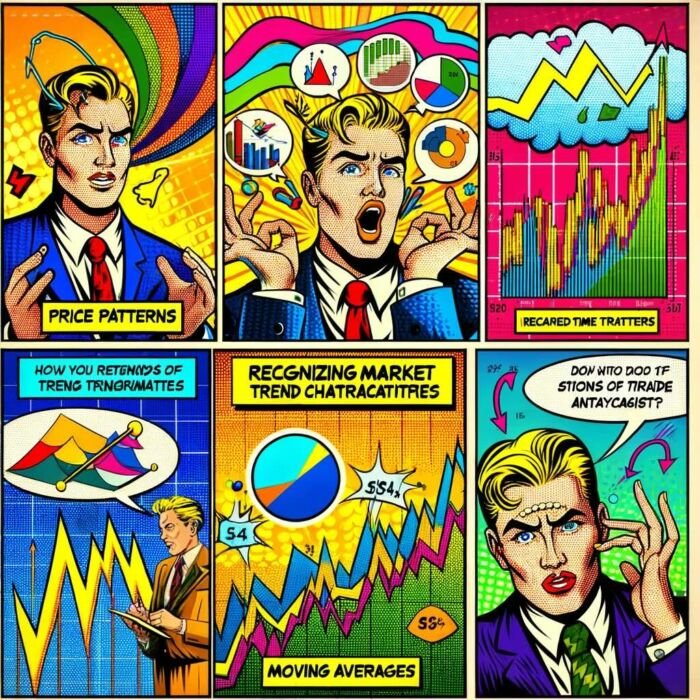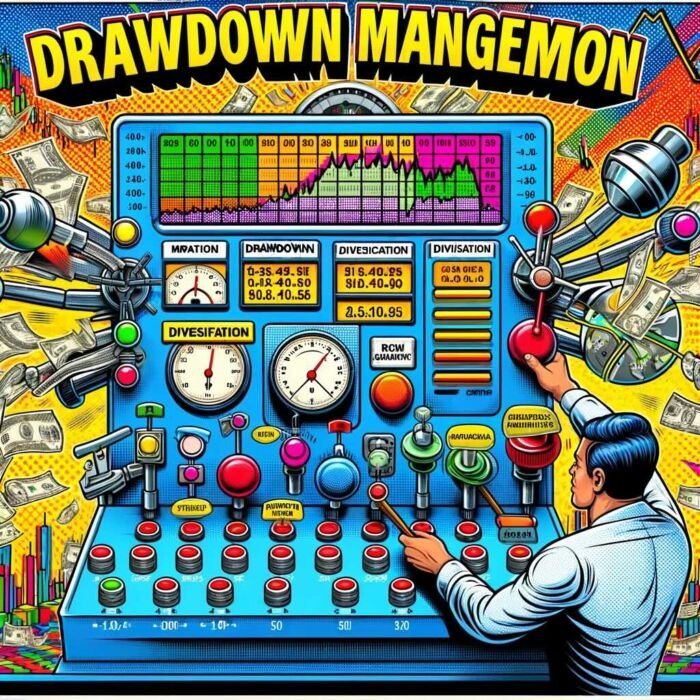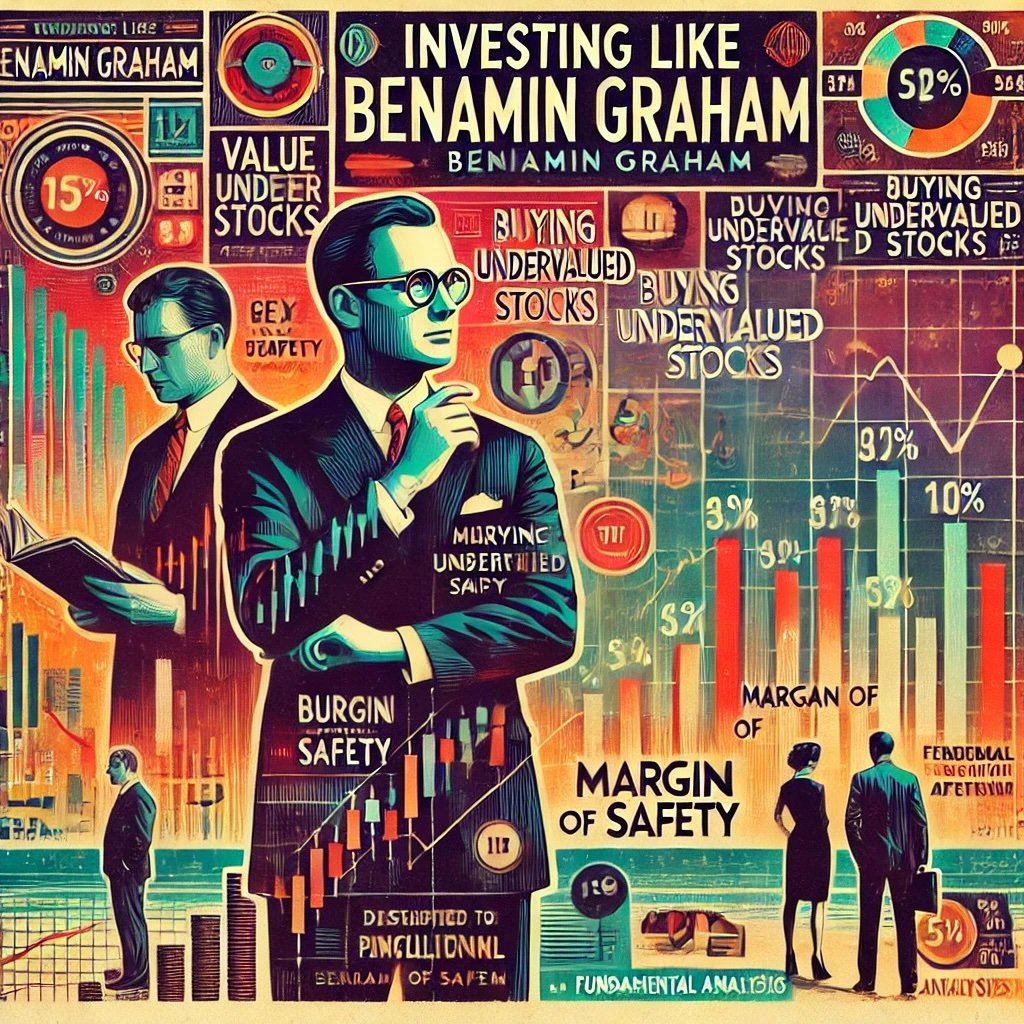Trend following, an investment strategy par excellence, hinges on the premise of capitalizing on market momentum. It’s predicated on the philosophy that financial markets exhibit discernible trends over time, which, if identified and followed, can lead to substantial gains. This approach eschews the traditional paradigms of market forecasting or company-specific analysis, instead focusing on the movement of market prices themselves as the primary indicator of where to invest.

At its core, trend following involves a systematic, quantitative approach to market analysis. Traders employing this method rely on algorithms and models that identify potential trends in asset prices. Once a trend is identified, the strategy dictates that one should invest in a manner that aligns with the direction of the trend – buying assets in an uptrend and selling or shorting assets in a downtrend. The beauty of this approach lies in its simplicity and adaptability; it can be applied across various asset classes, including stocks, bonds, commodities, and currencies, making it a versatile tool in an investor’s arsenal.

Importance of Trend Following in Investing
The importance of trend following in the investing world cannot be overstated. This strategy offers a robust framework for managing risk and maximizing returns in an inherently unpredictable market. One of the key advantages of trend following is its ability to profit in both rising and falling markets. Unlike traditional buy-and-hold strategies, which are heavily reliant on continually rising markets to yield returns, trend following thrives on volatility and market movement, regardless of direction.
source: ukspreadbetting on YouTube
Moreover, trend following provides a psychological edge. By relying on systematic, rule-based decision making, it removes emotional biases that often hinder investment performance. In tumultuous market environments, when investor sentiment can swing wildly, having a disciplined, emotion-free approach is invaluable. This method also offers diversification benefits. Since it can be applied across a range of asset classes, it allows for a more balanced and diversified investment portfolio, reducing the risk of significant losses due to market downturns in any single asset class.
Understanding Market Trends

Different Types of Trends
Deciphering market trends is a cornerstone of the trend-following approach, necessitating a deep understanding of their various manifestations. Predominantly, trends in financial markets can be classified into three archetypes: uptrends, downtrends, and sideways trends. Each of these trend types presents unique characteristics and trading opportunities.
- Uptrends: An uptrend is characterized by a sequence of higher highs and higher lows in asset prices, reflecting a market in a state of progressive ascent. This phenomenon indicates a prevailing sentiment of optimism among investors, often spurred by positive macroeconomic indicators, favorable corporate earnings reports, or other catalysts that instill confidence in the market’s future trajectory. In an uptrend, the demand for assets outpaces supply, propelling prices upward. Recognizing the onset of an uptrend and strategically positioning one’s portfolio to capitalize on this upward momentum is a quintessential aspect of trend following.
- Downtrends: Conversely, a downtrend is marked by a series of lower highs and lower lows, signifying a market in decline. This trend typifies a period of pervasive pessimism, where negative factors such as economic downturns, geopolitical unrest, or disappointing corporate performances dominate market sentiment. In a downtrend, the supply of assets exceeds demand, leading to a depreciation in prices. Astute trend followers perceive downtrends not merely as threats but as opportunities to profit through short-selling strategies or by reallocating investments to more stable asset classes.
- Sideways Trends: Sideways, or horizontal, trends occur when an asset’s price moves within a relatively stable range without a definitive direction. This pattern indicates a market equilibrium where supply and demand are closely balanced, often reflecting a period of uncertainty or consolidation. Recognizing a sideways trend is crucial, as traditional trend-following strategies may yield limited results in such market conditions, necessitating alternative approaches or a more cautious stance.

Recognizing Trend Characteristics
Discerning the nuances of market trends requires an arsenal of analytical tools and keen observational skills. Three primary methods used in trend analysis are price patterns, moving averages, and trendlines.
- Price Patterns: Price patterns are formations created by the fluctuations of an asset’s price on a chart. These patterns, such as head and shoulders, triangles, or flags, can offer predictive insights into future price movements. For instance, a head and shoulders pattern may signal a reversal from an uptrend to a downtrend. Mastery of pattern recognition enables investors to anticipate potential market shifts, positioning themselves advantageously in response to emerging trends.
- Moving Averages: Moving averages are pivotal in smoothing out price data to discern a clearer trend direction. By averaging the prices of an asset over a specific time frame, be it short-term (like a 10-day moving average) or long-term (like a 200-day moving average), these tools help identify underlying trends amidst market noise. A common strategy involves observing the crossovers of short-term and long-term moving averages, which can indicate potential bullish or bearish market turns.
- Trendlines: Trendlines are straight lines drawn on price charts, connecting a series of highs or lows. In an uptrend, a trendline is drawn along the higher lows, and in a downtrend, it is drawn along the lower highs. These lines not only help in identifying the prevailing trend but also in determining potential areas of support and resistance. A breach of a trendline may signal a weakening trend or an impending trend reversal, offering key insights for timely investment decisions.
source: Financial Wisdom on YouTube
A profound comprehension of market trends and their characteristics is vital for successful trend following. By skillfully employing these analytical tools, investors can navigate the complexities of market dynamics, making informed decisions that align with the prevailing market sentiment.
The Principles of Trend Following
Trend following, a strategy steeped in the art of precision and the science of probability, is governed by a set of fundamental principles. These tenets form the bedrock upon which successful trend-following strategies are built, ensuring that traders navigate the tumultuous waters of the financial markets with acumen and foresight.

Go with the Flow: Trading in the Direction of the Trend
The cardinal rule of trend following is encapsulated in the maxim: “Go with the flow.” This principle advocates for aligning trades with the prevailing market trend. The rationale is straightforward yet profound: it is more probable to garner profits by riding the existing momentum of the market rather than going against it. By identifying and aligning with uptrends or downtrends, traders increase their chances of success, capitalizing on the market’s inherent tendencies to persist in a particular direction. This approach eschews the precarious endeavor of predicting market reversals or timing market tops and bottoms, instead embracing the pragmatic strategy of trend alignment.

Risk Management
Integral to the fabric of trend following is an unyielding commitment to risk management. This discipline is the bulwark against the capriciousness of markets, designed to preserve capital and sustain trading longevity.
- Position Sizing: Position sizing is a critical aspect of risk management, dictating the amount of capital allocated to each trade. The goal is to size positions in a manner that balances the potential for profit with the risk of loss. This involves calculating the optimal trade size based on the volatility of the asset and the trader’s risk tolerance. A prudent position-sizing strategy ensures that no single trade jeopardizes the trader’s portfolio, allowing for the absorption of losses without derailing the overall investment strategy.
- Stop Losses: The use of stop losses is another cornerstone of risk management in trend following. Stop losses are predetermined exit points that automatically close a trade at a specific price level, thus limiting potential losses. These are set at levels where the initial rationale for the trade is invalidated, signaling a potential trend reversal or an erroneous trend identification. By implementing stop losses, traders enforce a disciplined approach to cutting losses, safeguarding their portfolios from significant drawdowns.
Discipline and Patience
Discipline and patience are virtues that underpin the effectiveness of trend-following strategies. This approach demands adherence to a predefined set of rules and algorithms, ensuring that trading decisions are based on logical, systematic criteria rather than whimsical, impulsive judgments. Patience is equally crucial, as trends take time to develop and mature. The ability to wait for the right opportunities and to stay the course during market fluctuations is essential for reaping the rewards of trend following.
source: Top Traders Unplugged on YouTube
Avoiding Emotional Decisions
In the realm of investing, emotions are often the nemesis of rational decision-making. Trend following, with its emphasis on systematic analysis and rule-based trading, seeks to mitigate the influence of emotional biases. Emotional decisions, such as fear-driven selling at market bottoms or greed-fueled buying at market tops, are antithetical to the principles of trend following. By relying on objective indicators and predefined strategies, traders insulate themselves from the psychological pitfalls that often ensnare market participants. This detachment from emotional reactivity enables traders to make decisions that are aligned with their long-term investment objectives and market realities.
The principles of trend following coalesce to form a robust, disciplined approach to trading. By adhering to these tenets, traders can navigate the complexities of financial markets with a strategy that is grounded in logical analysis, risk mitigation, and emotional equanimity. This approach, while not without its challenges, offers a path to consistent, long-term success in the ever-evolving world of investing.

Trend Following Strategies
In the arsenal of a trend follower, a variety of strategies and tools are employed, each with its unique methodology and theoretical underpinnings. These strategies, when applied judiciously, can harness the momentum of market trends, leading to potentially lucrative outcomes. We will explore some of the quintessential strategies in trend following: Moving Average Crossover, Breakout Trading, Donchian Channels, Parabolic SAR, and the application of the Relative Strength Index (RSI) in trend following.
Moving Average Crossover
The Moving Average Crossover strategy is a linchpin in trend following, renowned for its simplicity and efficacy. This strategy employs two moving averages of different timeframes – a shorter-term average and a longer-term average. The basic premise is that when the shorter-term average crosses above the longer-term average, it signals the commencement of an uptrend, suggesting a buying opportunity. Conversely, when the shorter-term average crosses below the longer-term average, it indicates the onset of a downtrend, signaling a potential selling or shorting opportunity. This method exemplifies the trend follower’s creed of responding to what the market is doing, rather than attempting to predict future movements.
Breakout Trading
Breakout trading is a dynamic strategy that focuses on identifying and capitalizing on significant price movements that breach predefined resistance or support levels. A breakout typically indicates a strong momentum in the market, suggesting a potential continuation of the trend. Traders implementing this strategy place trades when the price moves beyond a certain threshold – a high or low that the asset has not surpassed in a significant period. The effectiveness of breakout trading lies in its ability to capture the early stages of a trend, thus maximizing the potential for profit.

Donchian Channels
Developed by Richard Donchian, the Donchian Channels strategy is a trend-following approach that utilizes a channel created by the highest high and the lowest low of an asset over a set number of periods. The channel consists of three lines – the upper line, the lower line, and the middle line, which is the average of the two. A typical application of this strategy involves initiating a buy position when the price breaks above the upper channel line, indicating an uptrend, and a sell position when it breaks below the lower channel line, indicating a downtrend. This strategy provides a clear, visual representation of the market’s volatility and trend direction.
Parabolic SAR
The Parabolic SAR (Stop and Reverse) strategy, devised by J. Welles Wilder Jr., is designed to determine the direction of an asset’s momentum and pinpoint potential reversals. The system places dots on a chart that indicate potential stop and reverse points, hence the name ‘SAR’. In an uptrend, the dots are below the price bars and move upwards, signaling bullish momentum. Conversely, in a downtrend, the dots are above the price bars and move downwards. The Parabolic SAR is particularly effective in markets with a strong trend, offering clear signals for entry and exit points.
Relative Strength Index (RSI) in Trend Following
The Relative Strength Index (RSI) is a momentum oscillator that measures the speed and change of price movements, typically over a 14-day period. In the context of trend following, the RSI can be used to identify overbought or oversold conditions. An RSI reading above 70 is typically considered overbought, while a reading below 30 is considered oversold. However, in trend following, these traditional thresholds can be adjusted to align with the prevailing market trend. For instance, in a strong uptrend, an RSI level of 70 may not necessarily indicate an imminent reversal, but rather the strength of the ongoing trend.
In conclusion, these trend following strategies offer a spectrum of tools for traders to harness market trends effectively. Each strategy, with its unique characteristics and methodologies, contributes to the nuanced art of trend following. The judicious application of these strategies, combined with a rigorous risk management framework, forms the bedrock of successful trend following in the volatile realm of financial markets.

Technical Analysis Tools for Trend Following
In the domain of trend following, the utilization of technical analysis tools is indispensable. These tools provide the means to decipher market psychology, gauge momentum, and identify potential entry and exit points. Among the plethora of technical instruments available, certain tools stand out for their efficacy in trend-following contexts: Candlestick Patterns, Fibonacci Retracement Levels, MACD (Moving Average Convergence Divergence), and Bollinger Bands. Each of these tools offers unique insights into market dynamics, and when used synergistically, they can significantly enhance a trader’s ability to follow and capitalize on market trends.
Candlestick Patterns
Candlestick patterns, originating from Japan, are a form of financial chart representation that offers an in-depth view of price movements. Each candlestick provides visual cues about the opening, high, low, and closing prices of an asset within a specific timeframe. In the context of trend following, certain candlestick patterns serve as harbingers of potential trend reversals or continuations. For example, a ‘Bullish Engulfing’ pattern may indicate a forthcoming uptrend, while a ‘Bearish Engulfing’ pattern could signal an impending downtrend. Mastery of candlestick patterns allows traders to interpret market sentiment and make informed decisions based on the emotional state of the market participants.
Fibonacci Retracement Levels
Fibonacci Retracement is a tool based on the mathematical concept of the Fibonacci sequence. It is used to identify potential support and resistance levels, which are key areas where the market might temporarily reverse or continue the trend. These levels are derived by drawing horizontal lines at percentages of the Fibonacci sequence, typically at 23.6%, 38.2%, 50%, 61.8%, and 100% retracement of a price move. Traders use these levels to anticipate where prices might pause or reverse during a trend. The precision and universality of Fibonacci retracement levels make them a favored tool among trend followers for planning entries and exits.

MACD (Moving Average Convergence Divergence)
The MACD is a trend-following momentum indicator that shows the relationship between two moving averages of an asset’s price. It consists of the MACD line (the difference between two exponential moving averages), the signal line (a moving average of the MACD line), and the histogram (which displays the difference between the MACD and the signal line). The MACD is particularly useful in trend following for identifying changes in momentum, direction, and duration of trends. A crossover of the MACD line above the signal line indicates a bullish trend, while a crossover below signals a bearish trend. The MACD’s ability to blend trend and momentum information makes it a powerful tool in a trend follower’s toolkit.
Bollinger Bands
Bollinger Bands are a volatility indicator developed by John Bollinger. They consist of a middle band, which is a simple moving average, and two outer bands that are standard deviations away from the middle band. The bands expand and contract based on market volatility. In trend following, Bollinger Bands are used to identify overbought and oversold conditions, potential volatility breakouts, and trend continuations. When the price touches or breaches the upper band, it may indicate an overbought condition, and conversely, touching the lower band might indicate an oversold condition. Additionally, a narrowing of the bands often precedes a sharp price movement, signaling a potential new trend.
In summation, the strategic application of these technical analysis tools forms a comprehensive framework for trend following. By integrating insights from candlestick patterns, Fibonacci retracement levels, MACD, and Bollinger Bands, a trend follower can construct a nuanced and multifaceted approach to navigating the complexities of financial markets, enhancing their ability to identify, follow, and capitalize on market trends.

Risk Management in Trend Following
Risk management is the linchpin of success in trend following, a crucial discipline that undergirds the sustainability and profitability of trading strategies. In the unpredictable realm of financial markets, where the only certainty is uncertainty, the astute management of risk is what separates the perennially successful traders from the transiently lucky ones. This section delves into the core aspects of risk management in trend following: determining the optimal position size, setting stop-loss orders, managing drawdowns, and the role of diversification.
Determining the Optimal Position Size
Position sizing is a vital component of risk management, dictating the amount of capital to be allocated to each trade based on the assessed risk. The paramount goal of position sizing is to optimize the potential return while minimizing the risk of significant losses. This involves a meticulous calculation that considers the trader’s risk tolerance, the volatility of the asset, and the overall size of the trading portfolio. A commonly used method is the ‘percent risk’ model, which limits the risk on each trade to a fixed percentage of the total portfolio. This ensures that the impact of any single losing trade is contained and manageable, preserving the trader’s capital for future trading opportunities.
Setting Stop-Loss Orders
Stop-loss orders are an indispensable risk management tool in trend following. They are pre-set orders to sell an asset when it reaches a specific price, effectively putting a limit on the potential loss from a trade. The key to setting effective stop-loss orders lies in balancing the need to allow the asset enough room to ‘breathe’ and move with the market’s natural volatility, while also protecting the portfolio from excessive losses. Traders often use technical indicators, such as support and resistance levels, moving averages, or a set percentage from the entry price, to determine where to place their stop-loss orders. This disciplined approach ensures that losses are capped and that traders are not led by emotions or hope in the face of adverse market movements.

Managing Drawdowns
Drawdown management is the process of controlling the decline in the value of a trading account from its peak to its trough. Drawdowns are an inevitable aspect of trading; however, their management is crucial in preserving capital and maintaining the psychological fortitude necessary for long-term trading success. Effective drawdown management involves not only having a robust risk management system in place but also the flexibility to adapt one’s trading strategy in response to changing market conditions. This might include reducing position sizes, diversifying into less volatile assets, or temporarily reducing trading frequency during periods of high market uncertainty.
Diversification in Trend Following
Diversification is a cornerstone of risk management in trend following. It involves spreading investments across various asset classes, markets, and trading strategies to mitigate the risk of substantial losses. The rationale behind diversification is that different assets and markets often do not move in tandem; thus, losses in one area can be offset by gains in another. In trend following, diversification can also mean applying the strategy across different time frames or using a combination of trend-following indicators and tools. By diversifying, traders can smooth out their equity curve, reduce volatility in returns, and improve the resilience of their portfolio against market shocks.
Risk management is a multi-faceted and dynamic aspect of trend following that requires constant vigilance and adaptation. Through careful position sizing, disciplined use of stop-loss orders, effective drawdown management, and strategic diversification, trend followers can not only protect their capital but also position themselves to capitalize on the opportunities presented by the markets. This holistic approach to risk management is essential for navigating the complexities and uncertainties of financial trading and for achieving sustained success in trend following.

Psychology of Trend Following
The realm of trend following, while deeply rooted in statistical and analytical methods, is profoundly influenced by the psychological fortitude of the trader. The psychological dimension of trading is often the fulcrum upon which success or failure pivots. This section delves into the critical aspects of the psychology of trend following: the battle between emotion and discipline, the importance of adherence to a preconceived plan, strategies for coping with drawdowns and losses, and the indispensable role of confidence in the art of trading.
Emotion vs. Discipline
In the arena of trend following, the perennial struggle is between emotional reactivity and disciplined consistency. Emotions such as fear, greed, hope, and regret can cloud judgment, leading to impulsive decisions and deviations from well-thought-out strategies. Discipline, on the other hand, is the bastion against these emotional tempests. It demands adherence to a systematic approach, reliance on predefined rules, and unflinching execution of strategies regardless of the emotional turbulence that might ensue. The successful trend follower is one who masters the art of subjugating emotional impulses to the dictates of disciplined trading.

Sticking to the Plan
Central to disciplined trading is the principle of sticking to the plan. A well-conceived trading plan is a blueprint for action, outlining strategies, risk management parameters, and criteria for entry and exit points. The efficacy of a trading plan is only as robust as the trader’s commitment to adhering to it. Deviations from the plan, often prompted by emotional responses to market fluctuations, can derail the most sophisticated of strategies. Sticking to the plan ensures consistency in approach, a critical factor in evaluating the performance and effectiveness of trading strategies over time.
Dealing with Drawdowns and Losses
Drawdowns and losses are inescapable elements of the trading landscape. The psychological resilience to cope with these downturns is a defining characteristic of a successful trend follower. It involves maintaining a long-term perspective, understanding that losses are temporary setbacks in the broader context of a strategic trading journey. Coping with drawdowns also demands an objective analysis of the causes of losses, learning from them, and making the necessary adjustments to the trading plan. This process fosters a growth mindset, where setbacks are viewed as opportunities for learning and improvement rather than as demoralizing defeats.
The Importance of Confidence
Confidence is the cornerstone of a trader’s psychological arsenal. It is the fuel that powers the commitment to a trading plan, the resilience in the face of losses, and the discipline to override emotional impulses. However, confidence must be tempered with humility to avoid the pitfalls of overconfidence, which can lead to risk-taking and complacency. Confidence in trend following is built through experience, a deep understanding of the strategies employed, and a historical awareness of their performance. It is also nurtured by a continuous process of education and self-improvement, keeping abreast of market trends, and refining trading skills.
The psychology of trend following is as intricate and nuanced as its technical aspects. The interplay of emotion and discipline, the steadfast adherence to a trading plan, the resilience in dealing with losses, and the cultivation of a balanced confidence form the psychological bedrock upon which successful trend following is built. Mastery of these psychological facets is crucial in navigating the complex and often capricious world of financial markets, turning the art of trend following into a sustainable and profitable endeavor.

Backtesting and Optimization
In the intricate tapestry of trend following, backtesting and optimization are pivotal processes that enable traders to refine their strategies and enhance their efficacy. These practices involve scrutinizing historical data to test the viability of a trading strategy and making iterative improvements to optimize performance. This section will explore the nuances of backtesting and optimization, focusing on historical data analysis, fine-tuning trend following strategies, and the invaluable lessons derived from past mistakes.
Historical Data Analysis
Historical data analysis is the cornerstone of backtesting. It involves examining past market data to evaluate how a trading strategy would have performed under those conditions. This retrospective analysis provides a wealth of insights, offering a semblance of how a strategy might fare in future market scenarios. The process entails selecting relevant historical data, which should be comprehensive and representative of various market conditions, including bull markets, bear markets, and periods of high volatility. The strategy is then applied to this data to simulate trading decisions and outcomes. The meticulous analysis of historical data enables traders to assess key performance metrics such as profitability, drawdowns, win rates, and risk-to-reward ratios, providing a quantitative foundation for strategy evaluation.
Fine-Tuning Your Trend Following Strategy
The insights gleaned from backtesting form the basis for the fine-tuning of a trend following strategy. This iterative process involves making adjustments to the strategy’s parameters and rules to enhance its performance. Fine-tuning may include modifying entry and exit criteria, adjusting position sizes, or altering risk management thresholds. It may also involve the integration of additional indicators or filters to improve the strategy’s ability to identify and capitalize on market trends. The objective is to strike an optimal balance between maximizing returns and minimizing risks. This process is not a one-time exercise but an ongoing endeavor, necessitating continuous reassessment and adaptation in response to evolving market dynamics.

Learning from Past Mistakes
An integral part of backtesting and optimization is the analysis of past mistakes and losses. This introspective examination is not about ruminating over failed trades but about extracting constructive lessons from them. It involves identifying the reasons behind unsuccessful trades – whether they stem from flaws in the strategy, misinterpretation of market signals, or lapses in discipline. Learning from past mistakes is crucial in preventing their recurrence and in fostering a more robust and resilient trading strategy. It contributes to the development of a more sophisticated understanding of market behavior and the refinement of the trader’s skill set.
Backtesting and optimization are indispensable components of a successful trend following strategy. They provide a rigorous framework for strategy development and refinement, grounded in empirical analysis and continuous improvement. By thoroughly analyzing historical data, fine-tuning strategy parameters, and learning from past mistakes, trend followers equip themselves with a deeper understanding of market dynamics and a more effective arsenal of trading tools. This comprehensive approach is essential for achieving sustained success in the ever-changing landscape of financial markets, where the past, while not a perfect predictor of the future, remains a valuable guide.
Real-World Examples of Trend Following Success
The world of trend following is replete with illustrious examples of traders and funds that have achieved remarkable success by adhering to its principles. These real-world examples not only serve as a testament to the efficacy of trend following strategies but also offer invaluable lessons and insights. In this section, we will delve into the achievements of notable trend following traders, explore case studies of successful trend following funds, and distill the wisdom of trend following legends.

Notable Trend Following Traders
Throughout history, several traders have distinguished themselves through their exceptional application of trend following strategies. These individuals have not only amassed considerable wealth but also contributed to the evolution of the discipline through their innovative approaches and methodologies. For instance, traders like Richard Dennis, who co-founded the famous Turtle Trading experiment, demonstrated the potential of trend following when applied with discipline and rigor. Another exemplar is Ed Seykota, a pioneer in the use of computerized trading systems, who achieved staggering returns over his trading career by sticking to trend following principles. These traders underscore the potential of trend following to yield significant returns when coupled with a disciplined and systematic approach.
Case Studies of Trend Following Funds
Trend following funds, often structured as hedge funds or managed futures funds, provide compelling case studies of trend following success at an institutional level. These funds utilize sophisticated algorithms and quantitative models to identify and capitalize on market trends. A notable example is the success of AQR Capital Management, which has been a proponent of trend following strategies, integrating them into its broader quantitative investment approach. Another case study is the achievements of Winton Group, founded by David Harding, which has consistently delivered strong performance through its rigorous application of trend following principles. These funds demonstrate how trend following can be scaled and institutionalized, delivering robust returns across different market conditions.

Lessons from Trend Following Legends
The legacies of trend following legends are not just in their financial successes but also in the wisdom they impart. One of the most critical lessons is the importance of discipline and consistency. Trend following, at its core, is a test of one’s ability to adhere to a set of rules and strategies, even in the face of market adversity or personal doubt. Another key lesson is the value of risk management. The legends of trend following have consistently emphasized the importance of preserving capital and managing risks, as this is what sustains a trader over the long term. Additionally, these successful trend followers highlight the necessity of adaptability and continuous learning. The financial markets are ever-evolving, and staying abreast of new developments, technologies, and methodologies is crucial for ongoing success.
The real-world examples of trend following success offer a rich tapestry of insights and lessons. The achievements of notable traders and funds illustrate the potential of trend following strategies when executed with discipline, rigor, and an unwavering focus on risk management. Moreover, the wisdom of trend following legends provides a guiding light for aspiring traders, emphasizing the importance of discipline, risk management, and continuous evolution. These examples and lessons are a source of inspiration and knowledge for anyone looking to navigate the complex and rewarding world of trend following.
Combining Trend Following with Other Strategies
In the sophisticated tapestry of investment strategies, trend following often shines brightest when woven together with other complementary approaches. This synergy not only enhances returns but also mitigates risks, leading to a more robust and balanced investment portfolio. This section explores the integration of trend following with other strategies, focusing on its combination with value investing, its interplay with quantitative strategies, and its role in portfolio diversification.

Trend Following and Value Investing
Trend following and value investing may seem like antithetical approaches at first glance, but their combination can yield a powerful investment strategy. Value investing, based on the principle of purchasing undervalued assets with strong fundamentals, provides a solid foundation for long-term investment. When paired with trend following, which capitalizes on market momentum, investors can enhance their returns by not only buying undervalued assets but also timing their entry and exit based on market trends.
This hybrid approach involves identifying fundamentally strong companies that are undervalued by the market and then applying trend following techniques to determine the optimal entry and exit points. By doing so, investors can benefit from the security of value investing while also capitalizing on short-term market trends, thus maximizing their potential returns.

Trend Following and Quantitative Strategies
The amalgamation of trend following with quantitative strategies represents a convergence of technical momentum analysis with rigorous quantitative modeling. Quantitative strategies use mathematical and statistical models to identify trading opportunities and are particularly adept at processing large datasets to uncover market patterns.
Incorporating trend following into quantitative strategies can enhance the model’s predictive power. For instance, a quantitative model may use a range of variables to predict market movements, and the addition of trend following indicators like moving averages or momentum oscillators can provide further confirmation of these predictions. This combination allows for a more nuanced approach, where the precision of quantitative analysis is complemented by the market timing capabilities of trend following.
Trend Following in Portfolio Diversification
Trend following plays a vital role in the broader context of portfolio diversification. In a diversified portfolio, different investment strategies and asset classes are combined to reduce risk and volatility. Trend following, with its unique characteristic of capitalizing on market movements, can be an effective hedge against the downside risks associated with other investment strategies.
By including trend following strategies, a portfolio can benefit from its ability to generate positive returns in both rising and falling markets. This is particularly useful during market downturns or periods of high volatility, where traditional investment strategies might underperform. Moreover, as trend following can be applied across various asset classes, including stocks, bonds, commodities, and currencies, it allows for a more dynamic and responsive approach to asset allocation, enhancing the portfolio’s ability to adapt to changing market conditions.
The combination of trend following with other investment strategies offers a multifaceted approach to investing. By integrating the market momentum focus of trend following with the fundamental analysis of value investing, the precision of quantitative strategies, and the risk mitigation of portfolio diversification, investors can create a more balanced, resilient, and potentially lucrative investment strategy. This holistic approach exemplifies the sophistication and adaptability required in the modern investment landscape, where a diverse array of tools and strategies is essential for navigating the complexities of the financial markets.
Trends in Trend Following
As the investment landscape continually evolves, so too does the art and science of trend following. This dynamic field is constantly influenced by technological advancements, shifting market paradigms, and the ever-changing tapestry of global economic conditions. In this section, we will explore the emerging trends within trend following, focusing on the advent of algorithmic and AI-based trend following, shifts in asset classes, and the future prospects of this enduring strategy.

Algorithmic and AI-Based Trend Following
The incorporation of algorithmic trading and artificial intelligence (AI) represents a seismic shift in trend following. Algorithmic trend following leverages sophisticated computer programs to identify and execute trades based on predefined criteria. These algorithms are capable of processing vast amounts of data at incredible speeds, far surpassing human capabilities, which enables the identification of trends and trading opportunities with unprecedented precision and efficiency.
The integration of AI and machine learning takes this a step further. AI-based systems can learn from market data, adapt to new information, and evolve their trading rules over time. This allows for the creation of dynamic models that can adjust to changing market conditions, uncover complex patterns, and make predictive analyses. Such capabilities enhance the robustness of trend following strategies, offering a more adaptive and proactive approach to market dynamics.
Trends in Asset Classes
Trend following, traditionally dominant in commodities, equities, and currencies, is witnessing a diversification into new asset classes. One notable area is the burgeoning world of cryptocurrencies. The volatile and speculative nature of cryptocurrencies presents unique opportunities for trend following strategies. The application of trend following in this domain requires a nuanced understanding of the cryptocurrency market’s idiosyncrasies but offers the potential for high returns.
Another emerging area is environmental, social, and governance (ESG) investing. As the focus on sustainable investing grows, trend followers are increasingly incorporating ESG criteria into their analysis, identifying trends in socially responsible investments. This shift not only aligns with the growing societal emphasis on sustainability but also opens new avenues for capitalizing on emerging trends in socially conscious consumer and investor behavior.

Future Prospects of Trend Following
Looking to the future, the prospects of trend following remain promising, albeit with evolving challenges and opportunities. One of the key future challenges will be adapting to increasingly sophisticated and efficient markets. As more players employ algorithmic and AI-based systems, the competitive edge will lie in developing more advanced models and unique data sources.
Another area of future development is the integration of trend following with other cutting-edge technologies, such as blockchain and quantum computing. These technologies have the potential to further revolutionize data processing and security, offering new possibilities for trend following strategies.
Additionally, the macroeconomic and geopolitical landscape will continue to play a crucial role in shaping market trends. Trend followers will need to stay attuned to global economic shifts, policy changes, and emerging market dynamics to remain effective.
The realm of trend following is set to continue its evolution, driven by technological advancements, diversification into new asset classes, and a dynamic global economic environment. The future of trend following lies in embracing these changes, adapting strategies to harness new opportunities, and continually refining approaches to stay ahead in the complex and ever-changing world of financial markets. This continuous evolution underscores the enduring relevance and versatility of trend following as a fundamental strategy in the investment landscape.
Conclusion: Trend Following
As we reach the denouement of this comprehensive exploration into the world of trend following, it is appropriate to reflect on the journey undertaken, the insights garnered, and the path forward for those aspiring to master this venerable trading strategy.
Principles Of Trend Following
This odyssey through the realm of trend following has illuminated several key tenets and strategies intrinsic to its successful application. We commenced with an understanding of the fundamental principles of trend following, emphasizing the importance of aligning with market momentum, rigorous risk management, and the necessity of discipline and emotional fortitude. We explored a variety of trend following strategies, including the classic moving average crossover, breakout trading, and the utilization of technical tools such as Donchian Channels, Parabolic SAR, and the Relative Strength Index.
Our journey delved into the intricacies of risk management, a cornerstone of sustainable trading practice, highlighting the significance of optimal position sizing, the judicious use of stop-loss orders, and the art of managing drawdowns. Diversification, another critical aspect, was underscored as a means of enhancing portfolio resilience.
We also navigated the psychological landscape of trend following, recognizing the paramount importance of balancing emotion with discipline, adhering steadfastly to one’s trading plan, and cultivating the resilience necessary to contend with the inevitable market vicissitudes.
The exploration of backtesting and optimization provided insight into the vital role of historical data analysis in refining and honing trend following strategies. Real-world examples of successful trend followers and funds offered practical illustrations and valuable lessons drawn from their experiences.
As we ventured into the contemporary trends shaping the future of trend following, the emergence of algorithmic and AI-based approaches, along with the exploration of new asset classes such as cryptocurrencies and ESG-focused investments, was highlighted. These trends underscore the dynamic and ever-evolving nature of the financial markets and the necessity for trend followers to adapt continually.

Aspiring Trend Followers
For those embarking on the journey of trend following, this guide offers both a foundation and an inspiration. Trend following is not merely a trading strategy but a philosophical approach to the markets, demanding not only technical acumen but also psychological resilience. The path is fraught with challenges, yet it is also replete with opportunities for those who are diligent, disciplined, and willing to continually learn and adapt.
The journey of a trend follower is one of perpetual evolution, where success is not measured solely by the accumulation of profits but also by the growth in one’s understanding of the markets and oneself. Aspiring trend followers are encouraged to embrace this journey with an open mind and a steadfast commitment to continuous improvement.

Resources for Further Learning About Trend Following
The pursuit of knowledge in trend following is an ongoing endeavor. A plethora of resources is available for those seeking to deepen their understanding and refine their skills. Books such as “Trend Following” by Michael Covel, and “The Complete TurtleTrader” by the same author, offer in-depth insights and practical advice. Online courses, webinars, and forums provide platforms for learning and discussion with fellow traders.
Furthermore, engaging with real-time market data, utilizing simulation trading platforms, and conducting regular backtests will help in applying theoretical knowledge to practical scenarios. Subscribing to financial news, following market analysts, and participating in investment communities can also augment one’s understanding of current market trends and dynamics.
In conclusion, the world of trend following is a rich and complex field, offering substantial rewards to those who navigate its depths with diligence, discipline, and an unwavering commitment to learning. This guide serves as a beacon, illuminating the path for aspiring trend followers, and inviting them to embark on a rewarding journey of financial and personal growth.
Important Information
Comprehensive Investment Disclaimer:
All content provided on this website (including but not limited to portfolio ideas, fund analyses, investment strategies, commentary on market conditions, and discussions regarding leverage) is strictly for educational, informational, and illustrative purposes only. The information does not constitute financial, investment, tax, accounting, or legal advice. Opinions, strategies, and ideas presented herein represent personal perspectives, are based on independent research and publicly available information, and do not necessarily reflect the views or official positions of any third-party organizations, institutions, or affiliates.
Investing in financial markets inherently carries substantial risks, including but not limited to market volatility, economic uncertainties, geopolitical developments, and liquidity risks. You must be fully aware that there is always the potential for partial or total loss of your principal investment. Additionally, the use of leverage or leveraged financial products significantly increases risk exposure by amplifying both potential gains and potential losses, and thus is not appropriate or advisable for all investors. Using leverage may result in losing more than your initial invested capital, incurring margin calls, experiencing substantial interest costs, or suffering severe financial distress.
Past performance indicators, including historical data, backtesting results, and hypothetical scenarios, should never be viewed as guarantees or reliable predictions of future performance. Any examples provided are purely hypothetical and intended only for illustration purposes. Performance benchmarks, such as market indexes mentioned on this site, are theoretical and are not directly investable. While diligent efforts are made to provide accurate and current information, “Picture Perfect Portfolios” does not warrant, represent, or guarantee the accuracy, completeness, or timeliness of any information provided. Errors, inaccuracies, or outdated information may exist.
Users of this website are strongly encouraged to independently verify all information, conduct comprehensive research and due diligence, and engage with qualified financial, investment, tax, or legal professionals before making any investment or financial decisions. The responsibility for making informed investment decisions rests entirely with the individual. “Picture Perfect Portfolios” explicitly disclaims all liability for any direct, indirect, incidental, special, consequential, or other losses or damages incurred, financial or otherwise, arising out of reliance upon, or use of, any content or information presented on this website.
By accessing, reading, and utilizing the content on this website, you expressly acknowledge, understand, accept, and agree to abide by these terms and conditions. Please consult the full and detailed disclaimer available elsewhere on this website for further clarification and additional important disclosures. Read the complete disclaimer here.





